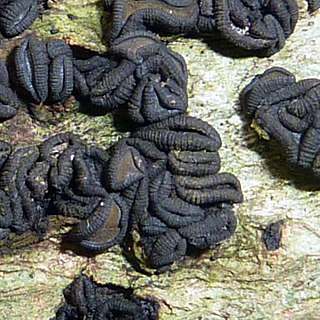
The Nectriaceae comprise a family of fungi in the order Hypocreales. It was circumscribed by brothers Charles and Louis René Tulasne in 1865. In 2020, an Outline of fungi was produced and listed 70 genera and about 1,336 species.

Pleosporaceae is a family of sac fungi. They are pathogenic to humans or saprobic on woody and dead herbaceous stems or leaves.

The Botryosphaeriaceae are a family of sac fungi (Ascomycetes), which is the type representative of the order Botryosphaeriales. According to a 2008 estimate, the family contains 26 genera and over 1500 species. Members of this order include notable plant pathogens.

The Botryosphaeriales are an order of sac fungi (Ascomycetes), placed under class Dothideomycetes. Some species are parasites, causing leaf spot, plant rot, die-back or cankers, but they can also be saprophytes or endophytes. They occur world-wide on many hosts. For example, in China, infections related to Botryosphaeriales have been recorded on numerous hosts such as grapes, Caragana arborescens,Cercis chinensis, Eucalyptus, Chinese hackberry, blueberry, forest trees, and various other woody hosts.

Phyllachoraceae is a family of sac fungi.
The Roussoellaceae are a family of fungi in the order Pleosporales. As accepted by Wijayawardene et al. 2020;
The Phaeosphaeriaceae are a family of fungi in the order Pleosporales. Species in the family have a cosmopolitan distribution, and are generally nectrotrophic or saprobic on a wide range of plants.
The Massarinaceae are a family of fungi in the order Pleosporales. Although taxa have a cosmopolitan distribution, they are better-known in temperate regions. They are thought to be saprobic in wood and bark; some species are weak pathogens.
Montagnula is a genus of fungi in the family Didymosphaeriaceae. The genus, circumscribed by mycologist Augusto Napoleone Berlese in 1896, contains an estimated 24 species in 2008, but is probably polyphyletic as currently circumscribed. It was originally placed in family Montagnulaceae, before that family was dissolved and it was later placed in family Didymosphaeriaceae, with 34 species.
Kalmusia is a genus of fungi in the family Didymosphaeriaceae. The genus was formerly placed in family Montagnulaceae, before that was dissolved. The widespread, genus was estimated to contain about 12 species in 2008, which has increased to 29 species in 2023.
Phaeosphaeriopsis is a genus of fungi in the family Phaeosphaeriaceae.

Phaeosphaeria is a genus of fungi in the family Phaeosphaeriaceae. It has about 95 species. The genus was circumscribed by Japanese mycologist Ichiro Miyake in 1909, with Phaeosphaeria oryzae assigned as the type species.

Herpotrichiellaceae is a family of ascomycetous fungi within the order Chaetothyriales and within the class Eurotiomycetes. It contains 16 genera and about 270 species. The type genus of the family, Herpotrichiella, is now synonymous with Capronia.
The Hyponectriaceae are a family of fungi, that was formerly in the order Xylariales. It was placed in the Amphisphaeriales order in 2020.
Roussoëlla is a genus of fungi in the family Roussoellaceae. The genus is characterized by two-celled ascospores, unitunicate asci with a small spherical apical ring that stains slightly blue with Melzer's reagent, and stromata with several perithecia. The genus was circumscribed by Italian mycologist Pier Andrea Saccardo in 1888, with Roussoella nitidula assigned as the type species. The generic name honours Marietta Hannon Rousseau, (1850–1926), who was a Belgian mycologist and taxonomist.
Keissleriella is a genus of fungi, that was originally placed in the Massarinaceae family, before being placed in the Lentitheciaceae family.

Massarina is a genus of fungi in the Massarinaceae family. Anamorph forms of species in Massarina include Acrocalymma, Ceratophoma, and Tetraploa. Massarina was circumscribed by Pier Andrea Saccardo in 1883. The widespread genus contains about 100 species.
Phragmocapnias is a genus of fungi in the family Capnodiaceae.

The Leptosphaeriaceae are a family of fungi in the order Pleosporales. The family was circumscribed by mycologist Margaret E. Barr in 1987. According to the Dictionary of the Fungi, the family contained 8 genera and 302 species. The family has a widespread distribution, but is especially prevalent in temperate regions. Species are either saprobic or grow as nectrotrophs on the stems or leaves of plants.

Rhytidhysteron is a genus of fungi in the family Patellariaceae. It has 21 species.









